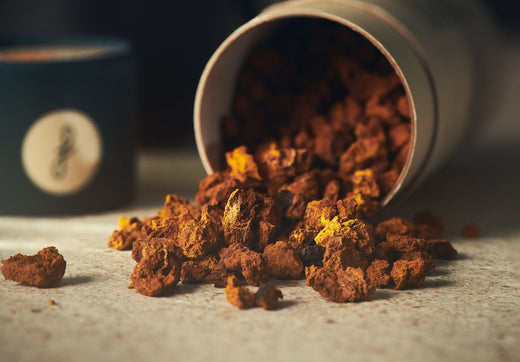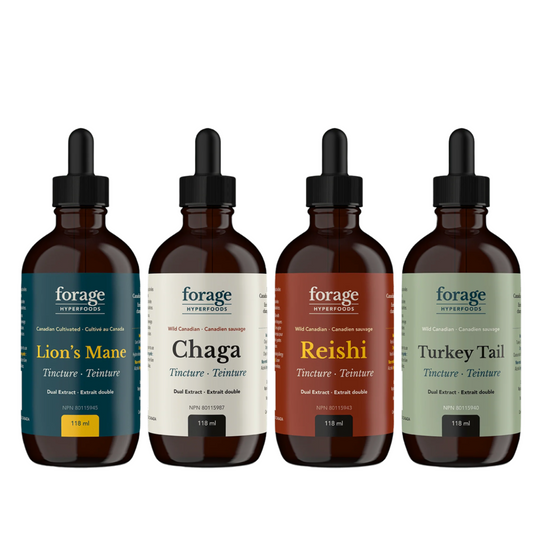
How Does Chaga Grow?
Share
Have you ever wondered how Chaga mushrooms grow in their natural habitat? Today, we’re going to discuss exactly that. After learning about the remarkable way in which Chaga grows in the wild, you’re sure to appreciate its unique magic even more.
First things first, what is Chaga?
Although it’s typically referred to as a mushroom, Chaga (Inonotus obliquus) is actually a sclerotia—a hardened mass of fungal mycelium. A parasitic fungus, Chaga primarily grows on birch trees in cold climates, like those in Canada, Siberia, Scandinavia, and some parts of the United States.
Chaga doesn’t pop up from the forest floor like most mushrooms. Rather, Chaga appears on birch trees as a black, charcoal-like mass (called a conk) with a woody, orange interior. Use this guide to help you identify Chaga mushrooms in nature. Despite its unsightly exterior, the wide-ranging health benefits of Chaga more than make up for its lack of aesthetic beauty. Chaga is packed with antioxidants, vitamins, and minerals, making it a functional fungi powerhouse. It’s been shown to support a strong immune system, provide anti-inflammatory benefits, support heart health, promote good digestion, and potentially play a role in cancer prevention, just to name a few. One interesting theory is that Chaga’s many beneficial compounds may be a result of natural adaptations by the fungus to withstand the cold, harsh climate in which it grows.
How does Chaga grow in the wild?
Chaga takes up to 20 years to fully develop on a host tree. The growth process starts when airborne Chaga spores penetrate a tree through injuries to the bark. Chaga starts growing on the inside of a birch tree, eventually protruding from the tree’s exterior as a black, crinkly mass as it matures. The interior of a Chaga mushroom is a rich gold-orange color with a corky texture, but this usually cannot be seen until it is harvested.
While the fungus continuously eats the wood, it softens or weakens its host until the tree reaches its decaying state called “tree facture,” eventually disintegrating from the inside out. Soon after the host tree dies, the Chaga fungus produces its seldom-seen “mushroom” phase, a porous mass that ruptures the birch bark. At this point, Chaga spores float through the air to find another host, and the process begins again.
A Chaga mass (called a conk) can grow to be over one foot in diameter, producing more nutrients as it grows. The growth rate depends on the conditions, but in general, it takes about five years for a Chaga mushroom to reach ten inches in diameter. Chaga should only be harvested once it is at least the size of a grapefruit.
Can Chaga grow on oak or poplar trees?
Chaga typically grows on birch trees, but it is also found on ash, elm, beech, alder, and hornbeam trees. One important fact to note, however, is that only Chaga from birch trees has the plant-based sterols, betulinic acid, and other constituents that can improve human health. When Chaga grows on other trees, it does not contain the same beneficial compounds.
Find a trusted source for your Chaga
Purchasing Chaga mushroom from a trusted supplier is the best way to ensure its effectiveness and safety. Not all Chaga products are created equal so be sure you’re getting yours from a company whose Chaga is organically grown, sustainably harvested, carefully extracted, and tested for quality and contaminants, such as heavy metals, pesticides, microbial contamination, and gluten. If a Chaga supplement lists any ingredients like “mycelium on grain” or other funky fillers, it's best to avoid it. To reap the full potential of this fungal powerhouse, seek a Chaga extract that uses wild-harvested Chaga. As with any supplement, get permission from your doctor before consuming Chaga.
The bottom line
Chaga mushroom is a very slow-growing fungus, but it is well worth the wait. It’s important to note that you must leave about one-third of the Chaga mushroom on the tree when harvesting it. This will allow the Chaga to continue growing so that you or somebody else can harvest it again and reap its health-enhancing benefits for years to come.
All referenced sources are linked in the blog.



